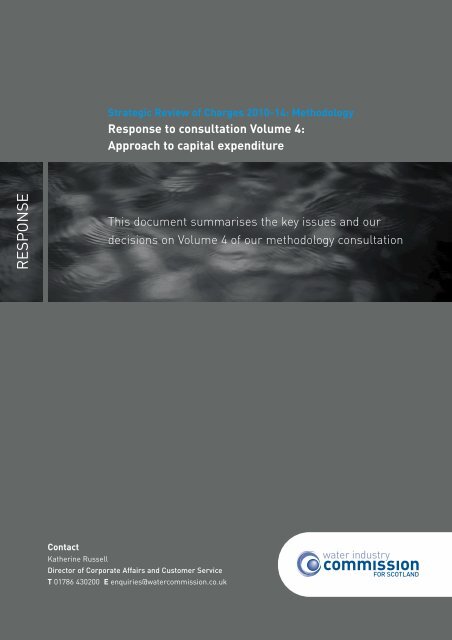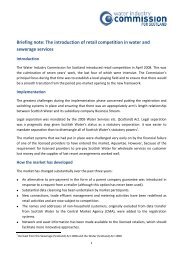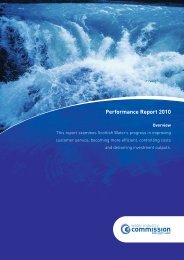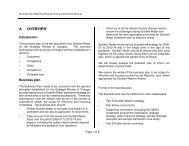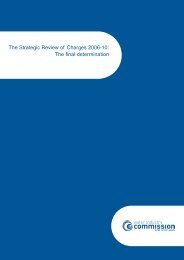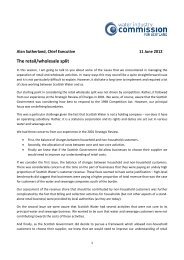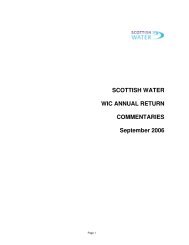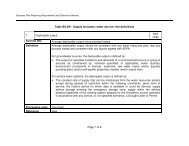Strategic Review of Charges 2010-14: Methodology Response to ...
Strategic Review of Charges 2010-14: Methodology Response to ...
Strategic Review of Charges 2010-14: Methodology Response to ...
You also want an ePaper? Increase the reach of your titles
YUMPU automatically turns print PDFs into web optimized ePapers that Google loves.
Volume 4: Approach <strong>to</strong> capital expenditureBackgroundContextEvery four years, we set limits on the prices that Scottish Water can charge cus<strong>to</strong>mers forwater and sewerage services. The next price review covers the period 1 April <strong>2010</strong> <strong>to</strong>31 March 20<strong>14</strong>.We issued a consultation in four volumes over the period May <strong>to</strong> July 2007. The consultationdocuments explained our proposed methodology for carrying out the price review. Volume 4<strong>of</strong> our methodology consultation sought stakeholders’ views on our approach <strong>to</strong> assessingthe level <strong>of</strong> capital expenditure <strong>to</strong> allow for at the price review.This document summarises the responses we received <strong>to</strong> Volume 4 and our response.All <strong>of</strong> the responses are available in full on our website at www.watercommission.co.uk.BACKGROUNDAssociated documents• ‘Our approach <strong>to</strong> the <strong>2010</strong>-<strong>14</strong> price review: A consultation’, Water Industry Commissionfor Scotland, December 2006.• ‘The <strong>Strategic</strong> <strong>Review</strong> <strong>of</strong> <strong>Charges</strong> 2006-10: The final determination’, Water IndustryCommission for Scotland, November 2005.• ‘<strong>Strategic</strong> <strong>Review</strong> <strong>of</strong> <strong>Charges</strong> <strong>2010</strong>-<strong>14</strong>: <strong>Methodology</strong>. Volume 4: Approach <strong>to</strong> capitalexpenditure’, Water Industry Commission for Scotland, July 2007.• Information papers 17 <strong>to</strong> 25, Water Industry Commission for Scotland, July 2007.Water Industry Commission for Scotland1
Volume 4: Approach <strong>to</strong> capital expenditureRESPONSES AND APPROACHWhat respondents saidRespondents generally welcomed our proposals <strong>to</strong> assess the extent <strong>of</strong> investment that canbe delivered efficiently within a single regula<strong>to</strong>ry control period. A number <strong>of</strong> respondentscommented that the fac<strong>to</strong>rs we proposed <strong>to</strong> consider were appropriate. Some made morespecific comments.Representatives <strong>of</strong> the civil engineering industry suggested that the industry was wellcapable <strong>of</strong> delivering Scottish Water’s current investment run rate <strong>of</strong> £500-600 million a year.They stated that the industry delivers outputs more efficiently when there is an even spread<strong>of</strong> activities on project preparation, design and construction across the full regula<strong>to</strong>ry controlperiod.One respondent suggested that the future investment programme should not be undulylimited by fears about the capacity <strong>of</strong> the Scottish civil engineering industry. They suggestedthat the capacity <strong>of</strong> the UK-wide construction industry should be considered.Respondents also generally welcomed our intention <strong>to</strong> explore with stakeholders how a morestrategic, long-term approach <strong>to</strong> investment planning could be taken. One respondentsuggested that a view <strong>of</strong> investment <strong>of</strong> up <strong>to</strong> 25 years would considerably help the process <strong>of</strong>agreeing investment priorities.Another respondent supported the proposal, but warned against encouraging Scottish Water<strong>to</strong> focus on larger projects at the expense <strong>of</strong> delaying smaller projects.Our approachWe have commissioned independent research in<strong>to</strong> the size <strong>of</strong> investment programme thatcan be delivered efficiently. This research will consider the fac<strong>to</strong>rs we outlined in our originalconsultation. We agree that an assessment <strong>of</strong> the size <strong>of</strong> the investment programme that canbe delivered efficiently should take account <strong>of</strong> broader UK trends. This analysis is publishedwith this response <strong>to</strong> our consultation.We welcome support for our taking a longer term view <strong>of</strong> Scottish Water’s investmentrequirements where possible. We will look <strong>to</strong> work with Scottish Water and otherstakeholders <strong>to</strong> explore the scope for greater long-term planning and identify projects suchas the Glasgow <strong>Strategic</strong> Drainage Plan where longer term planning <strong>of</strong> the requiredresources may prove <strong>to</strong> be in the interests <strong>of</strong> cus<strong>to</strong>mers. However, we will be cautious aboutcommitting cus<strong>to</strong>mer resources <strong>to</strong> projects across regula<strong>to</strong>ry control periods where there issignificant uncertainty as <strong>to</strong> the required outcome and proposed solution. We note that suchuncertainty tends <strong>to</strong> increase with the length <strong>of</strong> investment planning horizons.4Water Industry Commission for Scotland
Volume 4: Approach <strong>to</strong> capital expenditureDefining and reviewing the scope <strong>of</strong> the investmentprogrammeConsultation proposalsIn September 2008, the Scottish Government will set out the investment outcomes it expectsScottish Water <strong>to</strong> deliver over the regula<strong>to</strong>ry control period. In our consultation we explainedthat we will ask Scottish Water <strong>to</strong> define a baseline for its capital programme that is fullyconsistent with the Scottish Government’s objectives. This baseline will be an agreed anddetailed list <strong>of</strong> outputs that Scottish Water will deliver. It is a key part <strong>of</strong> the regula<strong>to</strong>rycontract between Scottish Water and its cus<strong>to</strong>mers. Scottish Water will set out this baselinein its draft business plans.We explained that we will issue guidance <strong>to</strong> Scottish Water on its draft business plans on20 December 2007. This information requirement for the investment programme is a centralpart <strong>of</strong> our guidance. We proposed that the baseline investment programme should be clear,comprehensive and accessible. This will allow stakeholders <strong>to</strong> moni<strong>to</strong>r Scottish Water’sprogress in delivering the investment programme. It will also ensure that stakeholders’expectations are met.If Scottish Water expects an overhang from the investment financed under the current(2006-10) price review, it should provide similar information on the outputs that would bedelivered after March <strong>2010</strong>.We noted the importance <strong>of</strong> the proposed investment being appropriate <strong>to</strong> deliver theScottish Government’s objectives. We commented that it is critical that Scottish Water agreesthe outputs <strong>of</strong> its enhancement investment programme with SEPA and the DWQR. Bothregula<strong>to</strong>rs should agree that the outputs proposed by Scottish Water will achieve theoutcomes required by the Scottish Government.We proposed <strong>to</strong> ask the Reporter <strong>to</strong> carry out a detailed review <strong>of</strong> the information submittedby Scottish Water, with particular emphasis on an audit and challenge <strong>of</strong>:RESPONSES AND APPROACH• the scope <strong>of</strong> requirements;• the technical solutions proposed; and• the basis <strong>of</strong> cost estimates and their consistency with Scottish Water’s cost base.The output <strong>of</strong> our review should be a properly costed, fully defined list <strong>of</strong> the outputs <strong>of</strong>capital investment projects, which , if delivered in full, will meet the objectives set out by theScottish Government for the regula<strong>to</strong>ry control period.Water Industry Commission for Scotland5
Volume 4: Approach <strong>to</strong> capital expenditureRESPONSES AND APPROACHQuestion for consultationDo respondents have views on how we propose <strong>to</strong> define the scope <strong>of</strong> the investmentprogramme required <strong>to</strong> deliver ministerial objectives for the water industry?What respondents saidRespondents generally supported our proposed approach. One respondent suggested that ourapproach could be enhanced by requiring Scottish Water <strong>to</strong> prioritise projects, particularlywith regard <strong>to</strong> national regeneration projects. Another respondent suggested that localauthorities should play a greater role in the planning stages <strong>of</strong> the investment programme.One respondent expressed concern that issues regarding sustainable development were notspecifically mentioned in our proposal.Another respondent supported our proposal <strong>to</strong> carry out an independent review provided itis carried out transparently, and provides an opportunity for Scottish Water <strong>to</strong> comment.The same respondent, whilst recognising the necessity <strong>to</strong> set out investment proposals indetail, suggested that Scottish Water should, during the regula<strong>to</strong>ry control period, be able <strong>to</strong>vary the solutions that it planned <strong>to</strong> use <strong>to</strong> deliver outputs. Doing so would not remove theincentive for Scottish Water <strong>to</strong> seek out more efficient and innovative ways <strong>to</strong> deliver outputs.Our approachIt is for the Scottish Government <strong>to</strong> determine its objectives for the water industry. TheCommission’s duty is <strong>to</strong> allow Scottish Water sufficient resources such that it can deliverthese objectives at the lowest overall reasonable cost.We will carry out our review <strong>of</strong> Scottish Water’s investment programme as proposed. Informulating its programme, we would expect Scottish Water <strong>to</strong> have due regard <strong>to</strong> itsstatu<strong>to</strong>ry duty <strong>to</strong> act in the way best calculated <strong>to</strong> contribute <strong>to</strong> the achievement <strong>of</strong>sustainable development, as well as consulting with stakeholders, such as local authorities,as appropriate.We recognise the importance <strong>of</strong> carrying out our review <strong>of</strong> Scottish Water’s investmentprogramme as transparently as possible. We plan <strong>to</strong> publish a short paper on how we willconduct the review, including the process we will follow and opportunities for Scottish Water<strong>to</strong> comment.We note the rationale for allowing Scottish Water the flexibility <strong>to</strong> vary the solutions it uses <strong>to</strong>deliver the required outputs. However, such changes must be made in a transparent way andbe clearly linked <strong>to</strong> the outcomes required for cus<strong>to</strong>mers. It is important that allowingScottish Water such flexibility does not compromise the delivery <strong>of</strong> the Scottish Government’sobjectives in full. We have worked with the Scottish Government-chaired Output Moni<strong>to</strong>ringGroup (OMG) <strong>to</strong> devise ways in which such flexibility can be incorporated whilst maintainingScottish Water’s accountability.6Water Industry Commission for Scotland
Volume 4: Approach <strong>to</strong> capital expenditureDetermining an appropriate allowance for capitalexpenditureConsultation proposalsThe appropriate level <strong>of</strong> capital maintenanceWe explained that Ofwat employs a four-stage approach linked <strong>to</strong> the UKWIR commonframework for capital maintenance planning. Unfortunately there is currently insufficientinformation available in Scotland <strong>to</strong> implement the common framework. We proposed <strong>to</strong>work with Scottish Water <strong>to</strong> ensure that the necessary information is identified and collectedfor future use.As an alternative for this price review, we plan <strong>to</strong> improve our understanding <strong>of</strong> the requiredlevel <strong>of</strong> capital maintenance by asking Scottish Water <strong>to</strong> set out its plans in as much detail aspossible; although we recognised that some capital maintenance is reactive and undertakenin response <strong>to</strong> particular problems.We proposed <strong>to</strong> use Ofwat’s econometric modelling techniques <strong>to</strong> establish an initialestimate <strong>of</strong> the appropriate allowance for capital maintenance. This technique usesstatistical regression analysis <strong>to</strong> establish the relationship between the costs incurred bycompanies and a defined set <strong>of</strong> cost drivers.The scope for efficiencyWe explained that inefficient spending results in higher bills and/or reduced outputs.Cus<strong>to</strong>mers have a right <strong>to</strong> expect that Scottish Water will deliver its agreed investmentprogramme as efficiently as possible. Capital efficiency can be achieved in a number <strong>of</strong> ways,including improved strategic and project planning, better procurement and the use <strong>of</strong>innovative techniques.We proposed <strong>to</strong> use Ofwat’s cost base technique <strong>to</strong> assess the scope for efficiency in ScottishWater’s procurement. The Ofwat cost base technique uses capital works unit costs <strong>to</strong> assessthe relative efficiency <strong>of</strong> water companies in procuring and implementing defined capitalprojects.RESPONSES AND APPROACHFor capital enhancement expenditure, we proposed <strong>to</strong> require Scottish Water <strong>to</strong> narrow 75%<strong>of</strong> any assessed gap in its efficiency.For capital maintenance expenditure, we suggested increasing the modelled estimate <strong>of</strong> theamount <strong>of</strong> capital maintenance required in order <strong>to</strong> reflect the capital efficiency gap thatexists between Scottish Water and the companies south <strong>of</strong> the border. We proposed <strong>to</strong> usethe Ofwat cost base technique <strong>to</strong> establish the size <strong>of</strong> any efficiency gap.Water Industry Commission for Scotland7
Volume 4: Approach <strong>to</strong> capital expenditureRESPONSES AND APPROACHQuestion for consultationWhat are respondents’ views on how we propose <strong>to</strong> determine an appropriate allowance forcapital expenditure?What respondents saidOne respondent suggested that we should use all available evidence in making ourassessment <strong>of</strong> an allowance for capital maintenance, including the his<strong>to</strong>ric data available.The same respondent agreed that Scottish Water should be required <strong>to</strong> set out its capitalmaintenance requirements in as much detail as possible. However, the respondent notedthat it would only be possible <strong>to</strong> do so for specific projects above a given threshold as muchcapital maintenance expenditure was reactionary, and difficult <strong>to</strong> plan for precisely.Two respondents cautioned against a reliance on Ofwat’s benchmarking techniques, botheconometric modelling for capital maintenance and the cost base for capital enhancement.One respondent commented that our proposed catch up target <strong>of</strong> 75% <strong>of</strong> the assessedefficiency gap should be a maximum, given their concerns about the reliability <strong>of</strong>benchmarking with England and Wales.Our approachWe will ask Scottish Water <strong>to</strong> provide as much detail as possible on its capital maintenanceplans, and will use the his<strong>to</strong>ric data available where possible. We will use this information <strong>to</strong>assess the costs <strong>of</strong> maintaining or improving levels <strong>of</strong> service – not <strong>to</strong> second guess themanagerial priorities <strong>of</strong> Scottish Water. However, we are not convinced that there issufficiently reliable information <strong>to</strong> adopt the common framework approach <strong>to</strong> forecast capitalmaintenance requirements.We recognise concerns that capital maintenance expenditure is <strong>of</strong>ten reactive. We willtherefore request that Scottish Water only provides information on planned capitalmaintenance projects above £1 million. Other capital maintenance requirements can beidentified at programme level.During 2008-09 we intend <strong>to</strong> initiate an academic research project in<strong>to</strong> the use <strong>of</strong>econometric benchmarking modelling techniques in water regulation in Scotland. We willinvite Scottish Water <strong>to</strong> take part in and help inform this research.8
Volume 4: Approach <strong>to</strong> capital expenditureMoni<strong>to</strong>ring the delivery <strong>of</strong> agreed outputsConsultation proposalsWe explained that the Scottish Government had agreed <strong>to</strong> our recommendation <strong>to</strong> set up theOMG <strong>to</strong> moni<strong>to</strong>r the delivery <strong>of</strong> the current investment programme. We considered that it wasimportant that all stakeholders could moni<strong>to</strong>r Scottish Water’s progress in delivering outputsobjectively. In our view this required an agreed single source <strong>of</strong> information on progress.We noted that we planned <strong>to</strong> build on this progress by asking Scottish Water <strong>to</strong> set out in itsbusiness plans its expected delivery pr<strong>of</strong>ile for each agreed output. We would ask ScottishWater <strong>to</strong> indicate the progress that it will have <strong>to</strong> have made, at the end <strong>of</strong> each quarter, ifthe agreed outputs are <strong>to</strong> be delivered in full during the regula<strong>to</strong>ry control period.We proposed that the OMG should publish this information at the start <strong>of</strong> the regula<strong>to</strong>rycontrol period and report on progress annually.Question for consultationAre the methods that we propose for moni<strong>to</strong>ring Scottish Water’s performance in deliveringthe outputs required by the regula<strong>to</strong>ry contract appropriate?What respondents saidRespondents generally welcomed the OMG and the greater transparency the group provided.Two respondents welcomed the OMG, but warned that it should not tend <strong>to</strong>wards the‘micromanagement’ <strong>of</strong> Scottish Water and limit Scottish Water’s scope <strong>to</strong> take alternative,more cost-effective, approaches where possible.Our approachRESPONSES AND APPROACHWe believe it is important that the OMG works with Scottish Water <strong>to</strong> establish a realisticdelivery pr<strong>of</strong>ile against which progress can be moni<strong>to</strong>red and Scottish Water held <strong>to</strong> account.This will help <strong>to</strong> ensure that moni<strong>to</strong>ring remains objective and presents an accurate picture<strong>of</strong> Scottish Water’s delivery position.We will improve the way in which the performance <strong>of</strong> Scottish Water’s existing assets ismeasured by introducing further measures <strong>of</strong> serviceability <strong>to</strong> cus<strong>to</strong>mers. We plan <strong>to</strong> ensurethat we use the same suite <strong>of</strong> serviceability indica<strong>to</strong>rs <strong>to</strong> measure how assets perform forcus<strong>to</strong>mers as does Ofwat.Water Industry Commission for Scotland9
Volume 4: Approach <strong>to</strong> capital expenditureRESPONSES AND APPROACHEarly start <strong>to</strong> delivering <strong>2010</strong>-<strong>14</strong> regula<strong>to</strong>ry controloutputsConsultation proposalsWe explained that an early start <strong>to</strong> delivering the outputs required in the next regula<strong>to</strong>rycontrol period could be important, and may help avoid the significant dip in output deliverythat <strong>of</strong>ten characterises the start <strong>of</strong> a regula<strong>to</strong>ry control period.We suggested that Scottish Water may well want <strong>to</strong> request that it begins work on deliveringthe <strong>2010</strong>-<strong>14</strong> outputs during the current regula<strong>to</strong>ry control period. We explained that any suchrequest should meet the following criteria:• It is restricted <strong>to</strong> the assessment <strong>of</strong> feasibility, design, land purchase or activities required<strong>to</strong> gain planning or other regula<strong>to</strong>ry consents (unless there are good strategic reasons foradvancing proposed investment – such as visiting the same site twice in a short period).• It is proportionate given the likely size <strong>of</strong> the investment programme for the <strong>2010</strong>-<strong>14</strong>regula<strong>to</strong>ry control period.• It will not lead <strong>to</strong> delays in delivering outputs required in the current regula<strong>to</strong>ry controlperiod.• Scottish Water accepts that any early start spending will have <strong>to</strong> be included within theallowance for capital expenditure that is contained in our final determination <strong>of</strong> the<strong>2010</strong>-<strong>14</strong> price review.We proposed <strong>to</strong> ask Scottish Water <strong>to</strong> detail any proposals for an early start programme in itsbusiness plans.Question for consultationShould we consider an application by Scottish Water for an ‘early start’ <strong>to</strong> delivering therequired investment outputs for <strong>2010</strong>-<strong>14</strong>?10Water Industry Commission for Scotland
Volume 4: Approach <strong>to</strong> capital expenditureWhat respondents saidRespondents strongly supported the concept <strong>of</strong> an ‘early start’ programme. A number <strong>of</strong>respondents commented that allowing Scottish Water <strong>to</strong> start design and feasibility studiesprior <strong>to</strong> the beginning <strong>of</strong> the regula<strong>to</strong>ry control period would lead <strong>to</strong> a more efficient delivery<strong>of</strong> outputs during the regula<strong>to</strong>ry control period. They agreed that it would help <strong>to</strong> easefluctuations in investment during the period.Respondents also welcomed the proposals as a step <strong>to</strong>wards taking a longer termperspective <strong>to</strong> investment planning in the industry.Our approachWe welcome the support <strong>of</strong> stakeholders for the concept <strong>of</strong> allowing Scottish Water an ‘earlystart’. At present, we see no reason why financing should not be allowed during <strong>2010</strong>-<strong>14</strong> forScottish Water <strong>to</strong> make an early start on its 20<strong>14</strong>-18 investment programme.NEXT STEPSWith regard <strong>to</strong> Scottish Water’s next investment programme we have some concerns that anearly start could come at the cost <strong>of</strong> a late finish <strong>to</strong> the current investment programme.Therefore, we will carefully assess whether any request made by Scottish Water matches ourcriteria, and in particular we will have <strong>to</strong> satisfy ourselves that it will not lead <strong>to</strong> delays indelivering outputs required in the current regula<strong>to</strong>ry control period before determiningwhether an early start on the programme for the <strong>2010</strong>-<strong>14</strong> regula<strong>to</strong>ry control period should beallowed for.Next steps with the price reviewWe are making good progress in our programme <strong>of</strong> work for the price review, and would like<strong>to</strong> thank stakeholders for their invaluable contributions <strong>to</strong> date.On 30 June 2009 we will issue our draft determination <strong>of</strong> price limits. We will conductanother programme <strong>of</strong> consultation throughout the year with stakeholders before publishingour final determination on 30 November 2009.Water Industry Commission for Scotland11
20.12.07Water Industry Commission for ScotlandOchil House, Springkerse Business Park, Stirling FK7 7XE.T 01786 430200 F 01786 462018 E enquiries@watercommission.co.ukwww.watercommission.co.uk


